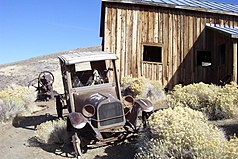Berlin Historic District (Nevada)
| Berlin Historic District | ||
|---|---|---|
| Car wreck in the ghost town of Berlin | ||
|
|
||
| Location: | Nevada , United States | |
| Next city: | Gabbs | |
| Founding: | 5th November 1971 | |
The Berlin Historic District is a cultural monument in Nye County in the US state of Nevada , United States , about 35 km east of Gabbs . The facility includes the ghost town of Berlin and is part of the Berlin-Ichthyosaur State Park .
The Berlin Historic District has been listed in the National Register of Historic Places since 1971 .
geography
The Berlin Historic District is located on the west side of the Shoshone Range , on the edge of the Humboldt-Toiyabe National Forest and is in the area of Nye County in Nevada . Nevada State Route 844 passes close to the facility .
The district is 2,035 meters above sea level.
Ghost town Berlin
The ghost town of Berlin forms the core of the Berlin Historic District . It is an uninhabited, former mining settlement. At times the city had 300 residents and 75 buildings.
Berlin is laid out in a U-shape and opens to the east.
history
The first mining activity in the area began in May 1863 when a small group of prospectors discovered silver in Union Canyon and set up camp. A year later the Union Mining District was founded, which included the settlements Union, Ione, Grantsville and, a little later, Berlin.
Even though the first prospecting report from the Berlin Canyon was available as early as 1869, mining operations did not begin properly until 1896. The city of Berlin was officially founded the following year.
The nearby city of Union functioned as a suburb of Berlin. The Berlin mine consisted of tunnels with a total length of 5 km and over time produced gold and silver with a total value of nearly one million US dollars.
However, Berlin could never flourish as much as the boomtowns Tonopah and Goldfield . The population was 300 in 1905, but after the panic of 1907 and the miners' strike that year, The Atlantic and Pacific Mining Company went bankrupt, causing mine workers to migrate. In 1911 Berlin was almost completely deserted and had to be dissolved.
On November 5, 1971, the city was added to the National Register of Historic Places as the Berlin Historical District .
State today
The 13 well-preserved buildings that still exist include the mine overseer's house, which is now used as the park's office, the control office and a workshop. A mill could also be preserved.
Even before the appropriation of Berlin in 1970 by the state of Nevada, the ghost town was tended, which is why it is still very well preserved today.
See also
Individual evidence
- ↑ National Park Service ( page no longer available , search in web archives ) Info: The link was automatically marked as defective. Please check the link according to the instructions and then remove this notice. (English)
- ↑ History of Berlin ( Memento of the original from April 4, 2009 in the Internet Archive ) Info: The archive link was inserted automatically and has not yet been checked. Please check the original and archive link according to the instructions and then remove this notice.


